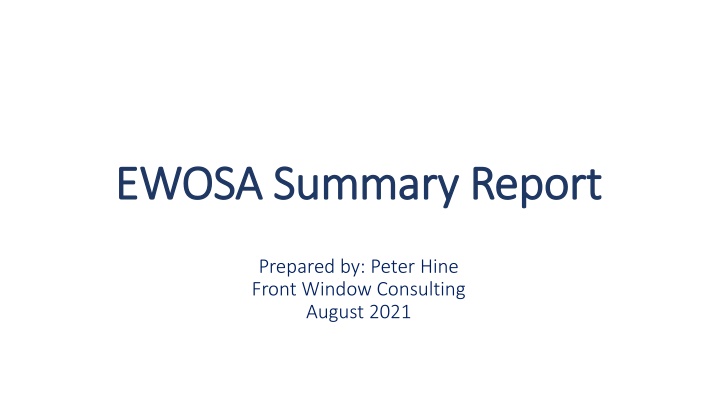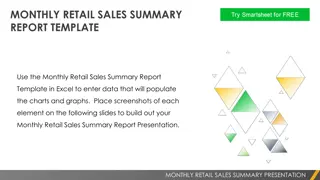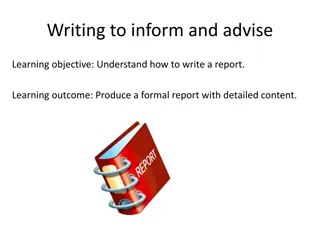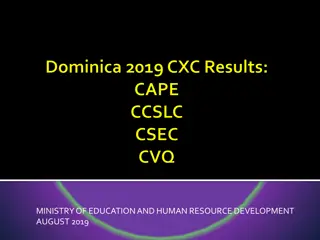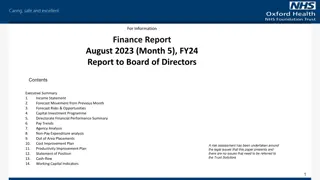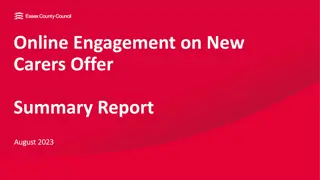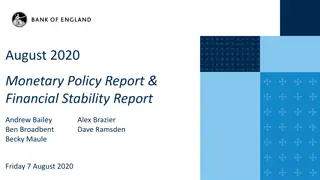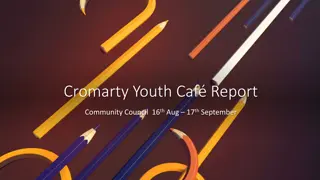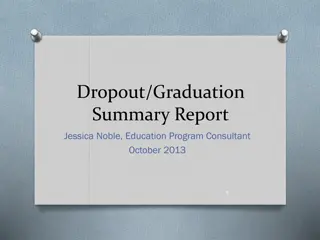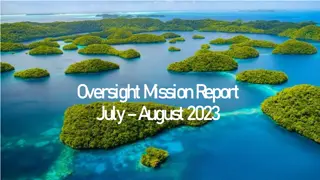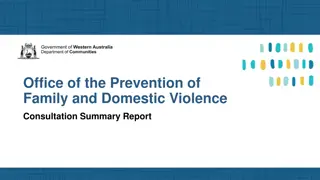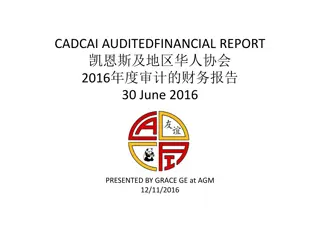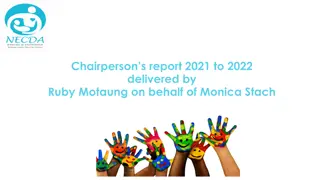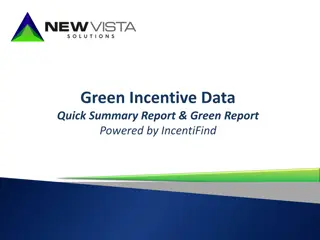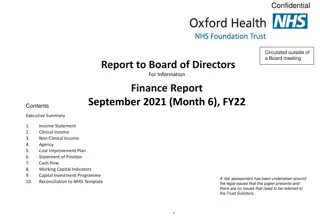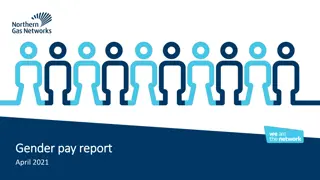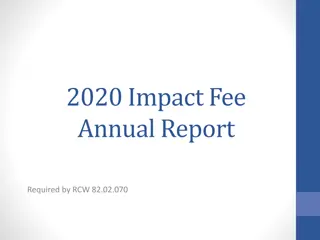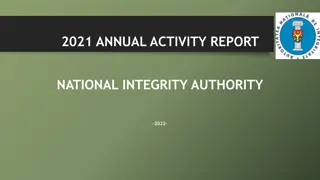EWOSA Summary Report August 2021
This report prepared by Peter Hine of Front Window Consulting presents key findings from surveys and interviews conducted to assess awareness of the Energy and Water Ombudsman of South Australia (EWOSA). It outlines methodology, public and customer survey results, and total awareness trends. The report highlights significant proportions of respondents reporting issues with energy, gas, or water supplies, as well as the main sources of awareness of EWOSA. Key findings include the types of problems reported, preferred contact methods, and respondents' understanding of the Ombudsman's role.
Download Presentation

Please find below an Image/Link to download the presentation.
The content on the website is provided AS IS for your information and personal use only. It may not be sold, licensed, or shared on other websites without obtaining consent from the author.If you encounter any issues during the download, it is possible that the publisher has removed the file from their server.
You are allowed to download the files provided on this website for personal or commercial use, subject to the condition that they are used lawfully. All files are the property of their respective owners.
The content on the website is provided AS IS for your information and personal use only. It may not be sold, licensed, or shared on other websites without obtaining consent from the author.
E N D
Presentation Transcript
EWOSA Summary Report EWOSA Summary Report Prepared by: Peter Hine Front Window Consulting August 2021
Methodology Methodology The data and information for the Review was collected using the following methodologies: An Online Survey of South Australian residents An Online Survey of EWOSA customers An Online Survey of EWOSA staff Executive Depth Interviews with 56 Internal and External Stakeholders conducted via telephone
General Public Survey General Public Survey
Key Findings Key Findings A significant proportion (46%) of those surveyed indicated that they had previously had an issue that would have prompted them to consider contacting any company or organisation in relation to their energy gas or water supply Awareness of the Energy and Water Ombudsman of South Australia has continued to increase and stood at 76% in total up from 45% in 2011 and 55% in 2015, as outlined in the following chart
Total Awareness of the Energy and Water Ombudsman of Total Awareness of the Energy and Water Ombudsman of South Australia South Australia Total Awareness of the Energy and Water Ombudsman of South Australia 90% 80% 76% 70% 60% 55% 55% 50% 2011 46% 45% 45% 2015 40% 2021 28% 30% 25% 24% 21% 19% 20% 13% 11% 10% 10% 4% 0% Total Aware of EWOSA Total Unaware of EWOSA Unprompted awareness Aware when named Aware when described
Customer Survey Customer Survey
Key Findings Key Findings General awareness of Ombudsman s Schemes (35%), word of mouth (33%) and Internet searches (15%) are the main sources of awareness of EWOSA The overwhelming majority (86%) of respondents indicated their problem related to electricity, while 10% named gas and 4% named water The main problems related to billing disputes (57%), the conduct of providers employees or agents (34%) and meter issues (26%) Telephone (76%) remains the main method of contacting EWOSA, with almost half naming email (49%) and others the EWOSA website/chat (23%) The overwhelming majority (85%) of those surveyed indicated that the role of the Energy and Water Ombudsman had been adequately explained to them
Key Findings Key Findings Almost nine in ten (86%) indicated that they were satisfied with their dealings with the Office of the Energy and Water Ombudsman Over eight in ten indicated that their issue had been resolved (82%) and that the Energy and Water Ombudsman was effective in handling the process (81%) Almost nine in ten (86%) indicated that they would recommend the Energy and Water Ombudsman to a friend or relative who had a complaint with their electricity, gas or water company they couldn t resolve Respondents satisfaction with their dealings with the Office of the Energy and Water Ombudsman was exceptionally high and stood at 90% of the total sample This is despite the fact that less than three quarters (74%) were satisfied with the outcome of their complaint
Staff Survey Staff Survey
Key Findings Key Findings Almost all (94%) of the staff surveyed indicated that the Energy and Water Ombudsman s Scheme delivers on its Constitution and Charter All staff (100%) are of the opinion that customers can access the Scheme with ease There were generally high levels of agreement with the following statements: The Scheme operates in an independent manner and customers are made aware of this by staff (100% agreed) Customers and staff are treated with politeness and respect (100% agreed) The staff have the tools and resources to do their jobs so as they deliver on the charter of the Scheme (100% agreed)
Key Findings Key Findings There were generally high levels of agreement with the following statements: Case outcomes are based on the Scheme s guiding principles ensuring equity and fairness to all parties (100% agreed) The Scheme provides quality customer service to members and customers in an equal manner (100% agreed) The jurisdiction of the Scheme is adequate to address the key concerns of consumers of energy and water services in today s markets (57% agreed) Members co-operate with the Scheme to resolve complaints in a prompt and fair manner (50% agreed)
Stakeholder Interviews Stakeholder Interviews
Key Findings Key Findings In a nutshell, there is a general consensus that the core role of EWOSA is to investigate, facilitate and resolve disputes between energy and water retailers and suppliers Almost all of the stakeholders interviewed rated EWOSA as nine out ten for achieving these objectives In terms of any aspects of EWOSA s areas of operations that are not meeting these objectives, only one or two stakeholders could name any EWOSA s main achievements over the past five years are considered to be its agility in responding to COVID (both internally and externally), its management of staff and budgets, its response to the rapidly changing energy market and its rapport with members of the Scheme
Key Findings Key Findings The Board and governance of EWOSA is generally regarded as appropriate, however, some believe that new members entering the Scheme should be represented on the Board, while others believe the status quo should remain The main challenges the Scheme has had to face in the past five (5) years were identified as the changing energy space, including new technologies, COVID, incorporating smaller players into the Scheme and, importantly, changing complaint levels which has impacted on the revenue base and staffing levels The ongoing response to COVID, handling emerging technologies and adequately representing new members of the scheme are regarded as the challenges the Scheme will face in the next five (5) years
Key Findings Key Findings In relation to new technologies, batteries, renewable energy and the use of coal were mentioned by most of the stakeholders interviewed. Many also mentioned the impact of electric cars, while others indicated that the use of communications mediums to reach younger consumers as important Discussions on cost reflective pricing for electricity and its impact on the Scheme drew mixed responses. Some felt that this pricing would be unable to be understood with the other dynamics impacting on bills, while others felt that it could result in an increased level of complaints Responses as to how complaints about solar services are currently being managed were also mixed. There was a general view among members that these are being well managed, however, some felt that these complaints (particularly those relating to problems with solar equipment) should not be managed within the jurisdiction of the Scheme. Customers were far more likely to indicate that the Scheme should have jurisdiction for matters relating to problems with solar equipment
Key Findings Key Findings In relation to customer hardship in terms of ability to pay, almost all stakeholders indicated that, due to COVID, disconnections and calling in debts had been held in abeyance and that at some point in the future (between three and twelve months) these significant debts would need to be paid most considered that this bubble would place a significant increase in work load on the Scheme In terms of ESCOSA regulated parties, off-grid electricity providers, councils etc. joining the Scheme, there was a mixed response some felt these parties should not be included in the Scheme, while others believed these parties should be. Almost all, however, felt that the number of complaints to the Scheme from these parties would be minimal
Key Findings Key Findings There was an overwhelming view that the Scheme has been extremely well promoted to the community and the media, especially through the CEO s efforts in this regard A number of groups in the community, however, were identified as those being more difficult to access, including older people, people from non-English speaking backgrounds, first nations peoples, those from lower socio-economic groups, those in regional areas and people with mental health issues
Key Findings Key Findings The following ratings questions all received well above average ratings between eight and ten (where 10 is the highest rating and 0 is the lowest rating), meaning all aspects tested received very high ratings, those being that: EWOSA is accountable to customers regarding complaints, decisions or systemic industry problems EWOSA s operations are fair and impartial in relation to the information provided to customers and any complaints made by these customers EWOSA s operations are efficient in relation to the information provided to customers and any complaints made by these customers EWOSA is accountable to Scheme members regarding complaints, discussions or any systemic industry problems EWOSA balances the interests and concerns of the different Scheme members
Key Findings Key Findings The following ratings questions all received well above average ratings between eight and ten (where 10 is the highest rating and 0 is the lowest rating), meaning all aspects tested received very high ratings, those being that: How well do you think EWOSA is placed to meet the challenges it will face in the next three to five years average rating of 8.8 among both internal and external stakeholders EWOSA s accountability to customers regarding complaints, decisions or systemic industry problems (internal stakeholders 8.5, external stakeholders 8.3) The fairness and impartiality of EWOSA s operations in relation to the information provided to customers and any complaints made by them (internal stakeholders 8.7, external stakeholders 8.8)
Key Findings Key Findings The following ratings questions all received well above average ratings between eight and ten (where 10 is the highest rating and 0 is the lowest rating), meaning all aspects tested received very high ratings, those being that: The efficiency of EWOSA s operations in relation to information provided to customers and complaints made by them (internal stakeholders 8.7, external stakeholders 8.5) The way in which EWOSA balances the interests and concerns of the different Scheme members (internal stakeholders 8.4, external stakeholders 8.3) (Internal Stakeholders only) How effectively the Board and Ombudsman work together to manage and operate EWOSA (rating of 8.6) (Internal Stakeholders only) How efficiently and effectively EWOSA is run (rating of 8.7)
Key Findings Key Findings Members had a very high level of understanding the current funding arrangements and were generally satisfied with them, however, some mentioned their frustration about being charged for frivolous claims made by consumers All of those interviewed indicated that the current arrangements ensure that EWOSA s Board administration and decision-making processes are sufficiently independent from retailers, energy suppliers and the Ombudsman There was almost unanimous agreement that the Board and the Ombudsman have worked efficiently and effectively together to manage and operate EWOSA and that EWOSA is efficiently and effectively run
Key Findings Key Findings When asked if there were any further comments about the following, there were virtually no suggestions, with internal stakeholders in favour of the constitution, the role of the Ombudsman, the role of the Board, the independence of the Ombudsman from the Board in relation to the decision making on cases, the scope, jurisdiction and the powers of the Scheme and the independence of the Ombudsman from members When asked if there were any additional comments they would like to make about EWOSA s structure, functions or operations that had not been covered in the interview, only two people offered any response
Conclusions Conclusions
Conclusions Conclusions General public awareness (prompted and unprompted) continues to rise 45% in 2011, 55% in 2015 and 76% in 2021 Customer satisfaction with the Scheme remains exceptionally high There is very strong support amongst members and for the Scheme in the way in which it balances the interests of consumers and members in a fair and reasonable manner All internal and external stakeholders interviewed were fulsome in their praise of the way in which the Ombudsman adapted to COVID restrictions and were able to continue to provide services to the community and members in a seamless manner
Conclusions Conclusions Members, regulators, community groups and government representatives were consistent in their views that the major challenge for the Scheme moving forward will be the need to diversify its response to emerging technologies and the issues arising from these changes The overwhelming majority were of the view that the Scheme should be a one stop shop for energy and water complaints, however, there needs to be a clear distinction between what is covered by consumer and energy law and what is dealt with by the Ombudsman
Conclusions Conclusions Stakeholders identified that there are a number of groups in the community who are less aware of the Scheme or find it more difficult to access the Scheme, including the elderly, people from non-English speaking backgrounds, people from CALD communities, people from remote communities and first nations people The staff surveyed almost unanimously expressed the view that they had a very strong understanding of their role and that they had the tools and resources to perform their role, their understanding of the purpose of the Scheme, the independence of the Scheme and how complaints are resolved
